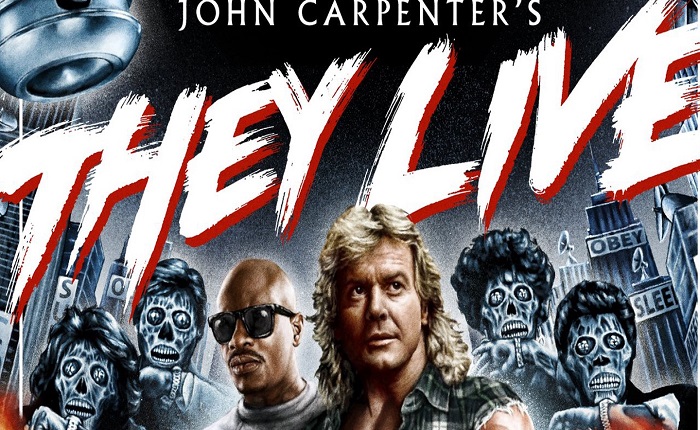They Live: Unraveling the Themes, Legacy, and Impact of a Cult Classic

Introduction
“They Live” is a 1988 sci-fi action film directed by John Carpenter that has earned cult classic status for its bold narrative, iconic imagery, and politically charged message. Set in a dystopian world where aliens secretly control society, “They Live” presents a biting critique of consumerism, capitalism, and societal control. The movie’s themes and memorable catchphrase, “I have come here to chew bubblegum and kick ass, and I’m all out of bubblegum,” have made it a pop culture phenomenon that still resonates today.
“They Live” is more than just an action-packed sci-fi film—it’s a commentary on social issues that are as relevant today as they were in the late 1980s. By diving into the film’s core elements, we can understand why “They Live” continues to be celebrated decades after its release.
Plot Overview of “They Live”
“They Live” follows the story of Nada (played by professional wrestler Roddy Piper), a drifter who discovers a pair of sunglasses that reveal a hidden reality. When Nada puts on the glasses, he sees that the world is controlled by humanoid aliens who use subliminal messaging to maintain their dominance over humanity. Billboards, advertisements, and magazines display phrases like “OBEY,” “CONSUME,” and “MARRY AND REPRODUCE,” while the aliens themselves are disguised as regular people.
As Nada becomes aware of this hidden control, he joins a resistance group that seeks to expose the truth and free humanity from alien oppression. “They Live” is a film that blends action, horror, and political commentary, making it a unique entry in both the sci-fi and action genres.
Themes of Consumerism and Control in “They Live”
At its core, “They Live” is a critique of consumerism and the way it shapes human behavior. The alien overlords in “They Live” maintain control by flooding society with subliminal messages that encourage conformity and mindless consumption. The imagery in “They Live,” such as the glasses revealing hidden commands, is a powerful metaphor for how advertising and media manipulate people.
“They Live” suggests that consumer culture, driven by corporations and media, is a tool used to suppress critical thought and maintain control. The aliens in “They Live” benefit from this system, exploiting human resources and keeping the population distracted with materialism and superficial desires.
The Political Allegory of “They Live”
“They Live” is often viewed as a political allegory, particularly critiquing the Reagan-era policies of the 1980s. Director John Carpenter has stated that “They Live” was a reaction to the increasing corporate greed and growing disparity between the wealthy elite and the working class. In “They Live,” the aliens represent the ruling class, using wealth and power to control society while keeping the masses complacent.
The film’s portrayal of alien overlords as the ruling elite in disguise serves as a metaphor for how governments and corporations manipulate the public for their own benefit. “They Live” explores themes of class division, inequality, and the ways in which powerful entities maintain their dominance over ordinary citizens.
The Iconic Sunglasses in “They Live”
One of the most memorable elements of “They Live” is the use of sunglasses as a symbol of awakening. In the film, Nada stumbles upon a box of special sunglasses that allow him to see the truth behind the world’s facade. When wearing the glasses, he can see the hidden messages that control society, as well as the true appearance of the aliens.
The sunglasses in “They Live” serve as a metaphor for critical thinking and awareness. They represent the ability to see through the illusions of consumerism and societal control, urging the viewer to question the world around them. This symbol has since become an iconic aspect of “They Live,” resonating with audiences as a call to action for greater consciousness in a world of manipulation.
The Infamous Fight Scene in “They Live”
“They Live” features one of the most iconic fight scenes in cinema history—a nearly six-minute-long brawl between Nada and his friend Frank (Keith David). The fight takes place after Nada tries to convince Frank to wear the special sunglasses and see the truth for himself. Frank, however, is resistant, and what follows is a prolonged, brutal battle.
This scene in “They Live” is notable not only for its length and intensity but also for its symbolic importance. The fight represents the struggle of getting people to see the truth, highlighting how difficult it can be to open someone’s eyes to the hidden realities of the world. “They Live” uses this moment to emphasize the importance of persistence in the face of ignorance and denial.
The Cultural Impact of “They Live”
Since its release, “They Live” has grown in cultural significance, transcending its status as a sci-fi action film. The film’s themes of consumerism, control, and societal oppression have made it a favorite among political activists, conspiracy theorists, and counterculture movements. The famous phrase “OBEY” has been appropriated by street artist Shepard Fairey for his artwork, further cementing “They Live” as a symbol of anti-authoritarian resistance.
“They Live” has also been referenced in various forms of media, from music videos to television shows, solidifying its place in pop culture. The film’s message about questioning authority and rejecting conformity continues to resonate, especially in an era where corporate power and government surveillance are frequent topics of discussion.
“They Live” and Modern-Day Relevance
More than three decades after its release, “They Live” remains highly relevant. The film’s critique of corporate influence, wealth inequality, and media manipulation speaks to the present-day concerns about the power of multinational corporations and the role of advertising in shaping public opinion.
In an age of social media, targeted advertising, and widespread surveillance, “They Live” serves as a cautionary tale about the dangers of uncritical consumption and the need to remain vigilant about who controls information. The film’s themes are especially poignant today, as society grapples with issues like fake news, corporate monopolies, and increasing economic disparity.
The Legacy of “They Live” in Film and Pop Culture
“They Live” has left an indelible mark on both film and pop culture. The film’s unique blend of sci-fi, horror, and social commentary has influenced numerous filmmakers and writers. Directors like Quentin Tarantino and Jordan Peele have cited “They Live” as an inspiration for their own work, with Peele’s “Get Out” sharing thematic parallels with Carpenter’s film.
Beyond its influence on filmmakers, “They Live” has also inspired artists, musicians, and activists. The film’s visuals and slogans have been widely used in protest movements and countercultural art, further embedding “They Live” in the cultural zeitgeist.
The Performances in “They Live”
The performances in “They Live” contribute significantly to the film’s lasting appeal. Roddy Piper’s portrayal of Nada is understated yet powerful, bringing a sense of everyman authenticity to the role. Piper’s background as a professional wrestler gave him the physicality needed for the film’s action scenes, while his delivery of iconic lines like “I have come here to chew bubblegum and kick ass” has made him a fan favorite.
Keith David’s performance as Frank adds depth to the film, providing a strong counterbalance to Piper’s character. The chemistry between the two leads, particularly in the infamous fight scene, elevates “They Live” beyond a typical action film, adding emotional weight to the narrative.
Director John Carpenter’s Vision
“They Live” is unmistakably a product of John Carpenter’s vision as a filmmaker. Known for his work in horror and sci-fi, Carpenter used “They Live” to express his frustration with the political and economic climate of the 1980s. Carpenter’s direction combines suspense, action, and satire to create a film that is both entertaining and thought-provoking.
Carpenter’s use of practical effects, minimalist score, and tight pacing all contribute to the atmosphere of “They Live.” The film’s low-budget aesthetic adds to its gritty, realistic feel, which enhances its message about the hidden power structures in society.
The Sci-Fi Horror Genre and “They Live”
“They Live” stands out as a unique entry in the sci-fi horror genre. While it contains elements of horror, such as the eerie reveal of the aliens’ true forms, it also incorporates action, satire, and political commentary. This blend of genres gives “They Live” a distinct tone that sets it apart from other sci-fi films of its era.
The horror in “They Live” is not derived from traditional monsters or supernatural threats but from the disturbing realization that the real monsters are those who control society. This subtle, psychological horror has made “They Live” a favorite among fans of the genre who appreciate films that challenge societal norms.
Conclusion: Why “They Live” Endures
“They Live” endures because it speaks to universal truths about power, control, and the human condition. Its message about the dangers of unchecked corporate influence and media manipulation resonates as strongly today as it did in 1988. “They Live” encourages viewers to question authority, think critically, and resist conformity, making it a timeless piece of cinema.
As we continue to navigate a world where the lines between reality and illusion are increasingly blurred, “They Live” serves as a powerful reminder to stay vigilant and aware of who holds the reins of power. Its lasting cultural impact and relevance ensure that “They Live” will continue to inspire future generations of filmmakers, artists, and activists.
FAQs
1. Is “They Live” based on a book?
Yes, “They Live” is based on the 1963 short story “Eight O’Clock in the Morning” by Ray Nelson. The film adapts the story’s themes of alien control and subliminal messaging into a cinematic narrative.
2. What is the meaning behind the sunglasses in “They Live”?
The sunglasses in “They Live” symbolize awareness and the ability to see through societal illusions. By wearing the glasses, characters can see the hidden truth about the alien-controlled world and the subliminal messages that maintain power.
3. What is the significance of the fight scene in “They Live”?
The fight scene in “They Live” represents the struggle to awaken others to the truth. It illustrates how difficult it can be to get people to confront uncomfortable realities and challenge their perceptions of the world.
4. Why is “They Live” considered a cult classic?
“They Live” is considered a cult classic due to its unique blend of action, sci-fi, and political commentary. Its critique of consumerism and corporate control, coupled with memorable lines and imagery, has made it a favorite among fans of alternative and countercultural films.
5. How does “They Live” remain relevant today?
“They Live” remains relevant today because its themes of consumerism, corporate control, and societal manipulation continue to resonate. In an era of increasing media influence and corporate power, “They Live” serves as a cautionary tale about the dangers of uncritical consumption and compliance.




